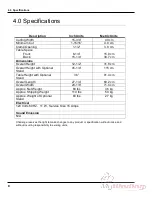
7.0 Knife Installation/Changing
17
entire width of paper is cut completely through. Do not allow the knife to cut too deep into the
cut stick. Cutting excessively deep into the stick will reduce its life.
10. Send dull knives to a knife grinder – do not attempt to sharpen your own knives! Knives that
do not have a minimum height of 1-1/2” (3.8 cm) will not function properly and should be
carefully discarded. See the Knife Care Tips Section below for additional information.
7.3 Knife Care Tips
! KNIFE SAFETY ! Knives are DANGEROUS!!! Knives are very sharp,
even after use. Keep the edge away from your body and keep the area clear of others when handling
knives. Never touch the cutting edge! To prevent personal injury and damage to the knife, always
keep knives in their holders with screws tightened. Even if you are aware of the dangers, others may
not be. Never attempt to hone, polish, or service the knife in any way. Failure to follow safety
procedures may result in severe lacerations or dismemberment.
7.3.1 Knife Blade Life
Knife blade life, or the time between sharpening, can be affected by many factors. One important
factor is the type of paper being cut. Abrasive paper, such as recycled paper, soft paper such as
newsprint and bound books can all significantly shorten knife blade life. In addition, if the knife depth
is set too deep, the knife will cut too deep into the cutting stick and can quickly dull the knife blade.
A knife can last between 2,000 and 5,000 cuts before it needs to be sharpened. Cutting soft paper
(such as newsprint paper) or paper with high post-consumer recycled content can cause the knife to
need sharpening after only 2,000 to 3,000 cuts. Cutting pure paper, such as bond paper with no
recycled content or hard paper can allow the knife to be used for as many as 5,000 cuts before it
needs to be sharpened. In all cases, the operator should continually check the quality of the cut to
determine when the knife blade needs to be sharpened. Some characteristics that indicate a blade
needs sharpening are:
•
The cut requires too much effort.
•
The sheets are not all cut to the same length (usually the top few sheets are longer than the
rest of the sheets - this is sometimes called “draw”).
•
Cut marks or scoring appears on the cut face of the paper.
•
The profile of the cut (side view) is not perpendicular to the table.
•
The cut does not appear straight when viewed from the top.
•
The knife makes a “rough” sound as it passes through paper.
•
Nicks are visible on the cutting edge of the knife.
7.3.2 Cutting Stick
A worn cutting stick can affect the cut quality of the bottom sheets. When this happens, the cut stick
can be rotated. Usually, the stick should be rotated one or two times between knife sharpening. Cut
sticks have a “wavy” shape to them and when rotated must be rotated a full 180° to keep a flat side
up. Each stick has 2 flat sides that can be used, after which it can be turned end to end, allowing the
2 flat sides to be used again, for a total of 4 positions per cut stick.
Содержание Challenge Spartan 150M
Страница 20: ...8 0 Footprint 19 8 0 Footprint...





































